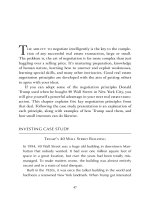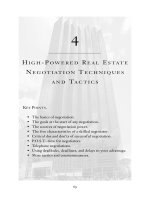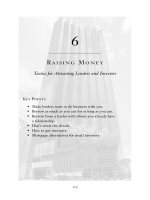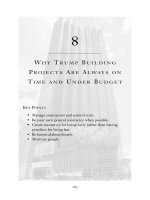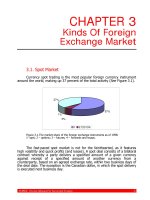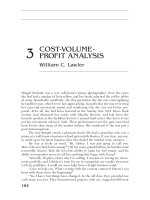Basic Mathematics for Economists - Rosser - Chapter 3 pps
Bạn đang xem bản rút gọn của tài liệu. Xem và tải ngay bản đầy đủ của tài liệu tại đây (162.17 KB, 29 trang )
3 Introduction to algebra
Learning objectives
After completing this chapter students should be able to:
• Construct algebraicexpressions for economic concepts involving unknown values.
• Simplify and reformulate basic algebraic expressions.
• Solve single linear equations with one unknown variable.
• Use the summation sign .
• Perform basic mathematical operations on algebraic expressions that involve
inequality signs.
3.1 Representation
Algebra is basically a system of shorthand. Symbols are used to represent concepts and
variables that are capable of taking different values.
For example, suppose that a biscuit manufacturer uses the following ingredients for each
packet of biscuits produced: 0.2 kg of flour, 0.05 kg of sugar and 0.1 kg of butter. One way
that we could specify the total amount of flour used is: ‘0.2 kg times the number of packets
of biscuits produced’. However, it is much simpler if we let the letter q represent the number
of packets of biscuits produced. The amount of flour required in kilograms will then be 0.2
times q, which we write as 0.2q.
Thus we can also say
amount of sugar required = 0.05q kilograms
amount of butter required = 0.1q kilograms
Sometimes an algebraic expression will have several terms in it with different algebraic
symbols representing the unknown quantities of different variables.
Consider the total expenditure on inputs by the firm in the example above. Let the price
(in £) per kilogram of flour be denoted by the letter a. The total cost of the amount of flour
the firm uses will therefore be 0.2q times a, written as 0.2qa.
If the price per kilogram of sugar is denoted by the letter b and the price per kilogram of
butter is c then the total expenditure (in £) on inputs for biscuit production will be
0.2qa + 0.05qb + 0.1qc
© 1993, 2003 Mike Rosser
When two algebraic symbols are multiplied together it does not matter in which order they
are written, e.g. xy = yx. This of course, is, the same rule that applies when multiplying
numbers. For example:
5 × 7 = 7 ×5
Any operation that can be carried out with numbers (such as division or deriving the
square root) can be carried out with algebraic symbols. The difference is that the answer
will also be in terms of algebraic symbols rather than numbers. An algebraic expression
cannot be evaluated until values have been given to the variables that the symbols represent
(see Section 3.2).
For example, an expression for the length of fencing (in metres) needed to enclose a square
plot of land of as yet unknown size can be constructed as follows:
The length of a side will be
√
A for a square that has area A square metres.
All squares have four sides.
Therefore the length of fencing = 4 × (length of one side) = 4
√
A.
Without information on the value of A we cannot say any more. Once the value of A is
specified then we can simply work out the value of the expression using basic arithmetic.
For example, if the area is 100 square metres, then we just substitute 100 for A and so
length of fencing = 4
√
A = 4
√
(100) = 4 × 10 = 40 metres
One of the uses of writing an expression in an algebraic form is that it is not neces-
sary to work out a solution for every different value of the unknown variable that one
is faced with. The different values can just be substituted into the algebraic expression.
In this section we start with some fairly simple expressions but later, as more complex
relationships are dealt with, the usefulness of algebraic representation will become more
obvious.
Example 3.1
You are tiling a bathroom with 10 cm square tiles. The number of square metres to be tiled is
as yet unknown and is represented by q. Because you may break some tiles and will have to
cut some to fit around corners etc. you work to the rule of thumb that you should buy enough
tiles to cover the specified area plus 10%. Derive an expression for the number of tiles to be
bought in terms of q.
Solution
One hundred 10 cm square tiles will cover 1 square metre and 110% written as a decimal is
1.1. Therefore the number of tiles required is
100q × 1.1 = 110q
© 1993, 2003 Mike Rosser
Test Yourself, Exercise 3.1
1. An engineering firm makes metal components. Each component requires 0.01
tonnes of steel, 0.5 hours of labour plus 0.5 hours of machine time. Let the number
of components produced be denoted by x. Derive algebraic expressions for:
(a) the amount of steel required;
(b) the amount of labour required;
(c) the amount of machine time required.
2. If the price per tonne of steel is given by r, the price per hour of labour is given by
w and the price per hour of machine time is given by m, then derive an expression
for the total production costs of the firm in question 1 above.
3. The petrol consumption of your car is 12 miles per litre. Let x be the distance you
travel in miles and p the price per litre of petrol in pence. Write expressions for
(a) the amount of petrol you use and (b) your expenditure on petrol.
4. Suppose that you are cooking a dinner for a number of people. You only know
how to cook one dish, and this requires you to buy 0.1 kg of meat plus 0.3 kg of
potatoes for each person. (Assume you already have a plentiful supply of any other
ingredients.) Define your own algebraic symbols for relevant unknown quantities
and then write expressions for:
(a) the amount of meat you need to buy;
(b) the amount of potatoes you need to buy;
(c) your total shopping bill.
5. You are cooking again! This time it’s a turkey. The cookery book recommends a
cooking time of 30 minutes for every kilogramme weight of the turkey plus another
quarter of an hour. Write an expression for the total cooking time (in hours) for
your turkey in terms of its weight.
6. Make up your own algebraic expression for the total profit of a firm in terms of the
amount of output sold, the price of its product and the average cost of production
per unit.
7. Someone is booking a meal in a restaurant for a group of people. They are
told that there is a set menu that costs £9.50 per adult and £5 per child, and
there is also a fixed charge of £1 per head for each meal served. Derive an
expression for the total cost of the meal, in pounds, if there are x adults and
y children.
8. A firm produces a good which it can sell any amount of at £12 per unit.
Its costs are a fixed outlay of £6,000 plus £9 in variable costs for each unit
produced. Write an expression for the firm’s profit in terms of the number of units
produced.
3.2 Evaluation
An expression can be evaluated when the variables represented by algebraic symbols are
given specific numerical values.
© 1993, 2003 Mike Rosser
Example 3.2
Evaluate the expression 6.5x when x = 8.
Solution
6.5x = 6.5(8) = 52
Example 3.3
A firm’s total costs are given by the expression
0.2qa + 0.05qb + 0.1qc
where q is output and a, b and c are the per unit costs (in £) of the three different inputs used.
Evaluate these costs if q = 1,000,a = 0.6,b = 1.3 and c = 2.1.
Solution
0.2qa + 0.05qb + 0.1qc = 0.2(1,000 ×0.6) + 0.05(1,000 × 1.3) +0.1(1,000 × 2.1)
= 0.2(600) + 0.05(1,300) + 0.1(2,100)
= 120 + 65 + 210 = 395
Therefore the total cost is £395.
Example 3.4
Evaluate the expression (3
x
+ 4)y when x = 2 and y = 6.
Solution
(3
x
+ 4)y = (3
2
+ 4)6 = (9 + 4)6 = 13 ×6 = 78
Example 3.5
A Bureau de Change will sell euros at an exchange rate of 1.62 euros to the pound and charges
a flat rate commission of £2 on all transactions.
(i) Write an expression for the number of euros that can be bought for £x (any given quantity
of sterling), and
(ii) evaluate it for x = 250.
© 1993, 2003 Mike Rosser
Solution
(i) Number of euros bought for £x = 1.62(x − 2).
(ii) £250 will therefore buy
1.62(250 −2) = 1.62(248) = e401.76
Test Yourself, Exercise 3.2
1. Evaluate the expression 2x
3
+ 4x when x = 6.
2. Evaluate the expression (6x + 2y)y
2
when x = 4.5 and y = 1.6.
3. When the UK government privatized the Water Authorities in 1989 it decided
that annual percentage price increases for water would be limited to the rate of
inflation plus z, where z was a figure to be determined by the government. Write
an algebraic expression for the maximum annual percentage price increase for
water and evaluate it for an inflation rate of 6% and a z factor of 3.
4. Make up your own values for the unknown variables in the expressions you have
writtenforTestYourself,Exercise3.1aboveandthenevaluate.
5. Evaluate the expression 1.02
x
+ x
−3.2
when x = 2.8.
6. A firm’s average production costs (AC) are given by the expression
AC = 450q
−1
+ 0.2q
1.5
where q is output. What will AC be when output is 175?
7. A firm’s profit (in £) is given by the expression 7.5q − 1650. What profit will it
make when q is 500?
8. If income tax is levied at a rate of 22% on annual income over £5,400 then:
(a) write an expression for net monthly salary in terms of gross monthly salary
(assumed to be greater than £450), and
(b) evaluate it if gross monthly salary is £2,650.
3.3 Simplification: addition and subtraction
Simplifying an expression means rearranging the terms in it so that the expression becomes
easier to work with. Before setting out the different rules for simplification let us work through
an example.
Example 3.6
A businesswoman driving her own car on her employer’s business gets paid a set fee per mile
travelled for travelling expenses. During one week she records one journey of 234 miles, one
of 166 miles and one of 90 miles. Derive an expression for total travelling expenses.
© 1993, 2003 Mike Rosser
Solution
If the rate per mile is denoted by the letter M then her expenses will be 234M for the first
journey and 166M and 90M for the second and third journeys respectively. Total travelling
expenses for the week will thus be
234M + 166M + 90M
We could, instead, simply add up the total number of miles travelled during the week and
then multiply by the rate per mile. This would give
(234 + 166 + 90) ×rate per mile = 490 × rate per mile = 490M
It is therefore obvious that, as both methods should give the same answer, then
234M + 166M + 90M = 490M
In other words, in an expression with different terms all in the same format of
(a number) × M
all the terms can be added together.
The general rule is that like terms can be added or subtracted to simplify an expression.
‘Like terms’ have the same algebraic symbol or symbols, usually multiplied by a number.
Example 3.7
3x + 14x + 7x = 24x
Example 3.8
45A − 32A = 13A
It is important to note that only terms that have exactly the same algebraic notation can be
added or subtracted in this way. For example, the terms x, y
2
and xy are all different and
cannot be added together or subtracted from each other.
Example 3.9
Simplify the expression 5x
2
+ 6xy − 32x + 3yx − x
2
+ 4x.
Solution
Adding/subtracting all the terms in x
2
gives 4x
2
.
Adding/subtracting all the terms in x gives −28x.
Adding/subtracting all the terms in xy gives 9xy.
(Note that the terms in xy and yx can be added together since xy = yx.)
© 1993, 2003 Mike Rosser
Putting all these terms together gives the simplified expression
4x
2
− 28x + 9xy
Infactallthebasicrulesofarithmetic(assetoutinChapter2)applywhenalgebraicsymbols
are used instead of actual numbers. The difference is that the simplified expression will still
be in a format of algebraic terms.
The example below illustrates the rule that if there is a negative sign in front of a set of
brackets then the positive and negative signs of the terms within the brackets are reversed if
the brackets are removed.
Example 3.10
Simplify the expression
16q + 33q − 2q − (15q − 6q)
Solution
Removing brackets, the above expression becomes
16q + 33q − 2q − 15q + 6q = 38q
Test Yourself, Exercise 3.3
1. Simplify the expression 6x − (6 − 24x) +10.
2. Simplify the expression 4xy + (24x − 13y) − 12 + 3yx − 5y.
3. A firm produces two goods, X and Y, which it sells at prices per unit of £26 and £22
respectively. Good X requires an initial outlay of £400 and then an expenditure of
£16 on labour and £4 on raw materials for each unit produced. Good Y requires a
fixed outlay of £250 plus £14 labour and £3 of raw material for each unit. If the
quantities produced of X and Y are x and y, respectively, write an expression in
terms of x and y for the firm’s total profit and then simplify it.
4. A worker earns £6 per hour for the first 40 hours a week he works and £9 per hour
for any extra hours. Assuming that he works at least 40 hours, write an expression
for his gross weekly wage in terms of H , the total hours worked per week, and
then simplify it.
3.4 Simplification: multiplication
When a set of brackets containing different terms is multiplied by a symbol or a number
it may be possible to simplify an expression by multiplying out, i.e. multiplying each term
within the brackets by the term outside. In some circumstances, though, it may be preferable
to leave brackets in the expression if it makes it clearer to work with.
© 1993, 2003 Mike Rosser
Example 3.11
x(4 + x) = 4x + x
2
Example 3.12
5(7x
2
− x) −3(3x
2
+ 6x) = 35x
2
− 5x − 9x
2
− 18x
= 26x
2
− 23x
Example 3.13
6y(8 + 3x) − 2xy + 12y = 48y + 18xy −2xy + 12y
= 60y + 16xy
Example 3.14
The basic hourly rate for a weekly paid worker is £8 and any hours above 40 are paid at £12.
Tax is paid at a rate of 25% on any earnings above £80 a week. Assuming hours worked
per week (H ) exceed 40, write an expression for net weekly wage in terms of H and then
simplify it.
Solution
gross wage = 40 × 8 + (H − 40)12
= 320 + 12H − 480
= 12H − 160
net wage = 0.75(gross wage − 80) +80
= 0.75(12H −160 − 80) + 80
= 9H − 120 −60 + 80
= 9H − 100
If you are not sure whether the expression you have derived is correct, you can try to check
it by substituting numerical values for unknown variables. In the above example, if 50 hours
© 1993, 2003 Mike Rosser
per week were worked, then
gross pay = (40 hours @ £8) + (10 hours @ £12)
= £320 + £120
= £440
tax payable = (£440 − £80)0.25 = (£360)0.25 = £90
Therefore
net pay = £440 − £90 = £350
UsingtheexpressionderivedinExample3.14,ifH=50then
net pay = 9H −100 = 9(50) −100 = 450 −100 = £350
This checks out with the answer above and so we know our expression works.
It is rather more complicated to multiply pairs of brackets together. One method that can be
used is rather like the long multiplication that you probably learned at school, but instead
of keeping all units, tens, hundreds etc. in the same column it is the same algebraic terms
that are kept in the same column during the multiplying process so that they can be added
together.
Example 3.15
Simplify (6 + 2x)(4 − 2x).
Solution
Writing this as a long multiplication problem:
6 + 2x ×
4 − 2x
Multiplying (6 + 2x)by−2x −12x − 4x
2
Multiplying (6 + 2x)by4 24+ 8x
Adding together gives the answer 24 − 4x − 4x
2
One does not have to use the long multiplication format for multiplying out sets of brackets.
The basic principle is that each term in one set of brackets must be multiplied by each term in
the other set. Like terms can then be collected together to simplify the resulting expression.
Example 3.16
Simplify (3x + 4y)(5x − 2y).
© 1993, 2003 Mike Rosser
Solution
Multiplying the terms in the second set of brackets by 3x gives:
15x
2
− 6xy (1)
Multiplying the terms in the second set of brackets by 4y gives:
20xy − 8y
2
(2)
Therefore, adding (1) and (2) the whole expression is
15x
2
− 6xy + 20xy − 8y
2
= 15x
2
+ 14xy − 8y
2
Example 3.17
Simplify (x + y)
2
.
Solution
(x + y)
2
= (x + y)(x + y) = x
2
+ xy + yx + y
2
= x
2
+ 2xy + y
2
The above answer can be checked by referring to Figure 3.1. The area enclosed in the
square with sides of length x + y can be calculated by squaring the lengths of the sides, i.e.
finding (x + y)
2
. One can also see that this square is made up of the four rectangles A, B,
C and D whose areas are x
2
,xy,xy and y
2
respectively – in other words, x
2
+ 2xy + y
2
,
which is the answer obtained above.
x
y
A
D
B
C
xy
Figure 3.1
© 1993, 2003 Mike Rosser
Example 3.18
Simplify (6 − 5x)(10 − 2x + 3y).
Solution
Multiplying out gives
60 − 12x + 18y − 50x + 10x
2
− 15xy = 60 −62x + 18y + 10x
2
− 15xy
Some expressions may be best left with the brackets still in.
Example 3.19
If a sum of £x is invested at an interest rate of r% write an expression for the value of the
investment at the end of 2 years.
Solution
After 1 year the investment’s value (in £) is x
1 +
r
100
After 2 years the investment’s value (in £) is x
1 +
r
100
2
One could multiply out but in this particular case the expression is probably clearer, and
also easier to evaluate, if the brackets are left in. The next section explains how in some
cases, some expressions may be ‘simplified’ by reformatted into two expressions in brackets
multiplied together. This is called ‘factorization’.
Test Yourself, Exercise 3.4
Simplify the following expressions:
1. 6x(x −4)
2. (x + 3)
2
− 2x
3. (2x + y)(x + 3)
4. (6x + 2y)(7x − 8y) +4y + 2y
5. (4x − y + 7)(2y − 3) + (9x − 3y)(5 +6y)
6. (12 − x + 3y + 4z)(10 +x + 2y)
7. A good costs a basic £180 a unit but if an order is made for more than 10 units this
price is reduced by a discount of £2 for every one unit increase in the size of an
order (up to a maximum of 60 units purchased), i.e. if the order size is 11, price
is £178; if it is 12, price is £176 etc. Write an expression for the total cost of an
order in terms of order size and simplify it. Assume order size is between 10 and
60 units.
© 1993, 2003 Mike Rosser
8. A holiday excursion costs £8 per person for transport plus £5 per adult and £3 per
child for meals. Write an expression for the total cost of an excursion for x adults
and y children and simplify it.
9. A firm is building a car park for its employees. Assume that a car park to accom-
modate x cars must have a length (in metres) of 4x +10 and a width of 2x +10. If
24 square metres will be specifically allocated for visitors’ cars, write an expres-
sion for the amount of space available for the cars of the workforce in terms of x
if x is the planned capacity of the car park.
10. A firm buys a raw material that costs £220 a tonne for the first 40 tonnes, £180
a tonne for the next 40 tonnes and £150 for any further quantities. Write an
expression for the firm’s total expenditure on this input in terms of the total amount
used (which can be assumed to be greater than 80 tonnes), and simplify.
3.5 Simplification: factorizing
Forsomepurposes(see,e.g.Section3.6belowandChapter6onquadraticequations)itmay
be helpful if an algebraic expression can be simplified into a format of two sets of brackets
multiplied together. For example
x
2
+ 4x + 4 = (x + 2)(x + 2)
This is rather like the arithmetical process of factorizing a number, which means finding all
the prime numbers which when multiplied together equal that number, e.g.
126 = 2 ×3 × 3 × 7
If an expression has only one unknown variable, x, and it is possible to factorize it into two
sets of brackets that do not contain terms in x to a power other than 1, the expression must
be in the form
ax
2
+ bx + c
However, not all expressions in this form can be factorized into sets of brackets that only
involve integers, i.e. whole numbers. There are no set rules for working out if and how an
expression may be factorized. However, if the term in x
2
does not have a number in front of
it (i.e. a = 1) then the expression can be factorized if there are two numbers which
(i) give c when multiplied together, and
(ii) give b when added together.
Example 3.20
Attempt to factorize the expression x
2
+ 6x + 9.
© 1993, 2003 Mike Rosser
Solution
In this example a = 1,b = 6 and c = 9.
Since 3 × 3 = 9 and 3 + 3 = 6, it can be factorized, as follows
x
2
+ 6x + 9 = (x + 3)(x + 3)
This can be checked as
x + 3 ×
x + 3
3x + 9
x
2
+ 3x
x
2
+ 6x + 9
Example 3.21
Attempt to factorize the expression x
2
− 2x − 80.
Solution
Since (−10) × 8 =−80 and (−10) + 8 =−2 then the expression can be factorized and
x
2
− 2x − 80 = (x − 10)(x + 8)
Check this answer yourself by multiplying out.
Example 3.22
Attempt to factorize the expression x
2
+ 3x + 11.
Solution
There are no two numbers which when multiplied together give 11 and when added together
give 3. Therefore this expression cannot be factorized.
It is sometimes possible to simplify an expression before factorizing if all the terms are
divisible by the same number.
Example 3.23
Attempt to factorize the expression 2x
2
− 10x + 12.
© 1993, 2003 Mike Rosser
Solution
2x
2
− 10x + 12 = 2(x
2
− 5x + 6)
The term in brackets can be simplified as
x
2
− 5x + 6 = (x − 3)(x − 2)
Therefore
2x
2
− 10x + 12 = 2(x − 3)(x − 2)
In expressions in the format ax
2
+bx +c where a is not equal to 1, then one still has to find
two numbers which multiply together to give c. However, one also has to find two numbers
for the coefficients of the two terms in x within the two sets of brackets that when multiplied
together equal a, and allow the coefficient b to be derived when multiplying out.
Example 3.24
Attempt to factorize the expression 30x
2
+ 52x + 14.
Solution
If we use the results that 6 × 5 = 30 and 2 ×7 = 14 we can try multiplying
5x + 7 ×
6x + 2
10x + 14
30x
2
+ 42x
This gives 30x
2
+ 52x + 14
Thus
30x
2
+ 52x + 14 = (5x + 7)(6x + 2)
Similar rules apply when one attempts to factorize an expression with two unknown variables,
x and y. This may be in the format
ax
2
+ bxy + cy
2
where a, b and c are specified parameters.
Example 3.25
Attempt to factorize the expression x
2
− y
2
.
© 1993, 2003 Mike Rosser
Solution
Inthisexamplea=1,b=0andc=−1.Thetwonumbers−1and1give−1when
multipliedtogetherand0whenadded.Thus
x
2
−y
2
=(x−y)(x+y)
Tocheckthis,multiplyout:
(x−y)(x−y)=x
2
−xy+y
2
−yx=x
2
−y
2
Example3.26
Attempttofactorizetheexpression3x
2
+8x+23.
Solution
As23isapositiveprimenumber,theonlypairsofpositiveintegersthatcouldpossiblybe
multipliedtogethertogive23are1and23.Thus,whateverpermutationsofcombinations
withtermsinxthatwetry,theterminxwhenbracketsaremultipliedoutwillbeatleast
24x,e.g.(3x+23)(x+1)=3x
2
+26x+23,whereasthegivenexpressioncontainsthe
term8x.Itisthereforenotpossibletofactorizethisexpression.
Unfortunately,itisnotalwayssoobviouswhetherornotanexpressioncanbe
factorized.
Example3.27
Attempttofactorizetheexpression3x
2
+24+16.
Solution
Althoughthenumberslookpromising,ifyoutryvariouspermutationsyouwillfindthatthis
expressiondoesnotfactorize.
Thereisnoeasywayoffactorizingexpressionsanditisjustamatteroftrialanderror.Do
notdespairthough!Asyouwillseelateron,factorizingmayhelpyoutouseshort-cut
methodsofsolvingcertainproblems.Ifyouspendagestryingtofactorizeanexpres-
sionthenthiswilldefeattheobjectofusingtheshort-cutmethod.Ifitisnotobvious
howanexpressioncanbefactorizedafterafewminutesofthoughtandexperimentation
withsomepotentialpossiblesolutionsthenitisusuallymoreefficienttoforgetfactoriza-
tionandusesomeothermethodofsolvingtheproblem.Weshallreturntothistopicin
Chapter6.
© 1993, 2003 Mike Rosser
Test Yourself, Exercise 3.5
Attempt to factorize the following expressions:
1. x
2
+ 8x + 16
2. x
2
− 6xy + 9y
2
3. x
2
+ 7x + 22
4. 8x
2
− 10x + 33
5. Make up your own expression in the format ax
2
+bx+c and attempt to factorize it.
Check your answer by multiplying out.
3.6 Simplification: division
To divide an algebraic expression by a number one divides every term in the expression by
the number, cancelling where appropriate.
Example 3.28
15x
2
+ 2xy + 90
3
= 5x
2
+
2
3
xy + 30
To divide by an unknown variable the same rule is used although, of course, where the
numerator of a fraction does not contain that variable it cannot be simplified any further.
Example 3.29
2x
2
x
= 2x
Example 3.30
4x
3
− 2x
2
+ 10x
x
=
x(4x
2
− 2x + 10)
x
= 4x
2
− 2x + 10
Example 3.31
16x + 120
x
= 16 +
120
x
© 1993, 2003 Mike Rosser
Example 3.32
A firm’s total costs are 25x + 2x
2
, where x is output. Write an expression for average cost.
Solution
Average cost is total cost divided by output. Therefore
AC =
25x + 2x
2
x
= 25 + 2x
If one expression is divided by another expression with more than one term in it then terms
can only be cancelled top and bottom if the numerator and denominator are both multiples
of the same factor.
Example 3.33
x
2
+ 2x
x + 2
=
x(x + 2)
x + 2
= x
Example 3.34
x
2
+ 5x + 6
x + 3
=
(x + 3)(x + 2)
x + 3
= x + 2
Example 3.35
x
2
+ 5x + 6
x
2
+ x − 2
=
(x + 2)(x + 3)
(x + 2)(x − 1)
=
x + 3
x − 1
Test Yourself, Exercise 3.6
1. Simplify
6x
2
+ 14x − 40
2x
2. Simplify
x
2
+ 12x + 27
x + 3
© 1993, 2003 Mike Rosser
3. Simplify
8xy + 2x
2
+ 24x
2x
4. A firm has to pay fixed costs of £200 and then £16 labour plus £5 raw materi-
als for each unit produced of good X. Write an expression for average cost and
simplify.
5. A firm sells 40% of its output at £200 a unit, 30% at £180 and 30% at £150. Write
an expression for the average revenue received on each unit sold and then simplify
it.
6. You have all come across this sort of party trick: Think of a number. Add 3.
Double it. Add 4. Take away the number you first thought of. Take away 3. Take
away the number you thought of again. Add 2. Your answer is 9. Show how this
answer can be derived by algebraic simplification by letting x equal the number
first thought of.
7. Make up your own ‘think of a number’ trick, writing down the different steps in
the form of an algebraic expression that checks out the answer.
3.7 Solving simple equations
We have seen that evaluating an expression means calculating its value when one is given
specific values for unknown variables. This section explains how it is possible to work
backwards to discover the value of an unknown variable when the total value of the expression
is given.
When an algebraic expression is known to equal a number, or another algebraic expression,
we can write an equation, i.e. the two concepts are written on either side of an equality sign.
For example
45 = 24 +3x
In this chapter we have already written some equations when simplifying algebraic expres-
sions. However, the ones we have come across so far have usually not been in a format where
the value of the unknown variables can be worked out. Take, for example, the simplification
exercise
3x + 14x − 5x = 12x
The expressions on either side of the equality sign are equal, but x cannot be calculated from
the information given.
Some equations are what are known as ‘identities’, which means that they must always be
true. For example, a firm’s total costs (TC) can be split into the two components total fixed
costs (TFC) and total variable costs (TVC). It must therefore always be the case that
TC = TFC +TVC
Identities are sometimes written with the three bar equality sign ‘≡’ instead of ‘=’, but
usually only when it is necessary to distinguish them from other forms of equations, such as
functions.
© 1993, 2003 Mike Rosser
Afunctionisarelationshipbetweentwoormorevariablessuchthatauniquevalueofone
variableisdeterminedbythevaluestakenbytheothervariablesinthefunction.(Functions
areexplainedmorefullyinChapter4.)Forexample,statisticalanalysismayshowthata
demand function takes the form
q = 450 − 3p
where p is price and q is quantity demanded. Thus the expected quantity demanded can be
predicted for any given value of p, e.g. if p = 60 then
q = 450 − 3(60) = 450 − 180 = 270
In this section we shall not distinguish between equations that are identities and those that
relate to specific values of functions, since the method of solution is the same for both.
We shall also mainly confine the analysis to linear equations with one unknown variable
whose value can be deduced from the information given. A linear equation is one where the
unknown variable does not take any powers other than 1, e.g. there may be terms in x but not
x
2
,x
−1
etc.
Before setting out the formal rules for solving single linear equations let us work through
some simple examples.
Example 3.36
You go into a foreign exchange bureau to buy US dollars for your holiday. You exchange
£200 and receive $343. When you get home you discover that you have lost your receipt.
How can you find out the exchange rate used for your money if you know that the bureau
charges a fixed £4 fee on all transactions?
Solution
After allowing for the fixed fee, the amount actually exchanged into dollars will be
£200 − £4 = £196
Let x be the exchange rate of pounds into dollars. Therefore
343 = 196x
343
196
= x
1.75 = x
Thus the exchange rate is $1.75 to the pound.
This example illustrates the fundamental principle that one can divide both sides of an
equation by the same number.
© 1993, 2003 Mike Rosser
Example 3.37
If 62 = 34 + 4x what is x?
Solution
Subtracting 34 from both sides gives
28 = 4x
then dividing both sides by 4 gives the solution
7 = x
This example illustrates the principle that one can subtract the same amount from both sides
of an equation.
The basic principles for solving equations are that all the terms in the unknown variable
have to be brought together by themselves on one side of the equation. In order to do this
one can add, subtract, multiply or divide both sides of an equation by the same number or
algebraic term. One can also perform other arithmetical operations, such as finding the square
root of both sides of an equality sign.
Once the equation is in the form
ax = b
where a and b are numbers, then x can be found by dividing b by a.
Example 3.38
Solve for x if 16x − 4 = 68 + 7x.
Solution
Subtracting 7x from both sides
9x − 4 = 68
Adding 4 to both sides
9x = 72
Dividing both sides by 9 gives the solution
x = 8
© 1993, 2003 Mike Rosser
Example 3.39
Solve for x if
4 =
96
x
Solution
Multiplying both sides by x
4x = 96
Dividing both sides by 4 gives the solution
x = 24
Example 3.40
Solve for x if 6x
2
+ 12 = 162.
Solution
Subtracting 12 from both sides
6x
2
= 150
Dividing through by 6
x
2
= 25
Taking square roots gives the solution
x = 5or − 5
Example 3.41
A firm has to pay fixed costs of £1,500 plus another £60 for each unit produced. How much
can it produce for a budget of £4,800?
Solution
budget = total expenditure on production
Therefore if x is output level
4,800 = 1,500 + 60x
© 1993, 2003 Mike Rosser
Subtracting 1,500 from both sides
3,300 = 60x
Dividing by 60 gives the solution
55 = x
Thus the firm can produce 55 units for a budget of £4,800.
Example 3.42
You sell 500 shares in a company via a stockbroker who charges a flat £20 commission rate
on all transactions under £1,000. Your bank account is credited with £692 from the sale of
the shares. What price (in pence) were your shares sold at?
Solution
Let price per share be x. Therefore, working in pence,
69,200 = 500x − 2,000
Adding 2,000 to both sides
71,200 = 500x
Dividing both sides by 500 gives the solution
142.4 = x
Thus the share price is 142.4p.
Test Yourself, Exercise 3.7
1. Solve for x when 16x = 2x + 56.
2. Solve for x when
14 =
6 + 4x
5x
3. Solve for x when 45 = 24 +3x.
4. Solve for x if 5x
2
+ 20 = 1,000.
5. If q = 560 − 3p solve for p when q = 314.
6. You get paid travelling expenses according to the distance you drive in your car
plus a weekly sum of £21. You put in a claim for 420 miles travelled and receive
an expenses payment of £105. What is the payment rate per mile?
7. In one module that you are studying, the overall module mark is calculated on the
basis of a 30 : 70 weighting between coursework and examination marks. If you
have scored 57% for coursework, what examination mark do you need to get to
achieve an overall mark of 40%?
© 1993, 2003 Mike Rosser
8.Yousell900sharesviayourbrokerwhochargesaflatrateofcommissionof£20
onalltransactionsoflessthan£1,000.Yourbankaccountiscreditedwith£340
fromthesharesale.Whatpricewereyoursharessoldat?
9.Yournetmonthlysalaryis£1,950.YouknowthatNationalInsuranceandpension
contributionstake15%ofyourgrosssalaryandthatincometaxisleviedatarate
of25%ongrossannualearningsabovea£5,400exemptionlimit.Whatisyour
grossmonthlysalary?
10.Youhave64squarepavingstonesandwishtolaythemtoformasquarepatioin
yourgarden.Ifeachpavingstoneis0.5metressquare,whatwillthelengthofa
sideofyourpatiobe?
11.AfirmfacesthemarginalrevenuescheduleMR=80−2qandthemarginalcost
scheduleMC=15+0.5qwhereqisquantityproduced.Youknowthatafirm
maximizesprofitwhenMC=MR.Whatwilltheprofit-maximizingoutputbe?
3.8Thesummationsign
Thesummationsign
canbeusedincertaincircumstancesasashorthandmeansofexpress-
ingthesumofanumberofdifferenttermsaddedtogether.(isaGreekletter,pronounced
‘sigma’.)Therearetwowaysinwhichitcanbeused.
Thefirstiswhenonevariableincreasesitsvalueby1ineachsuccessiveterm,asthe
examplebelowillustrates.
Example3.43
Anewfirmsells30unitsinthefirstweekofbusiness.Salesthenincreaseattherateof30units
perweek.Ifitcontinuesinbusinessfor5weeks,itstotalcumulativesaleswillthereforebe
(30×1)+(30×2)+(30×3)+(30×4)+(30×5)
Youcanseethatthenumberrepresentingtheweekisincreasedby1ineachsuccessiveterm.
Thisisratheracumbersomeexpressiontoworkwith.Wecaninsteadwrite
salesrevenue=
5
i=1
30i
Thismeansthatoneissummingalltheterms30iforvaluesofifrom1to5.
Ifthenumberofweeksofbusinessnwasnotknownwecouldinsteadwrite
salesrevenue=
n
i=1
30i
Toevaluateanexpressioncontainingasummationsign,onemaystillhavetocalculatethe
valueofeachtermseparatelyandthenaddup.However,spreadsheetscanbeusedtodo
tediouscalculationsandinsomecasesshort-cutformulaemaybeused(seeChapter7).
© 1993, 2003 Mike Rosser
Example 3.44
Evaluate
n
i=3
(20 + 3i) for n = 6
Solution
Note that in this example i starts at 3. Thus
6
i=3
(20 + 3i) = (20 + 9) + (20 + 12) +(20 + 15) + (20 +18)
= 29 + 32 + 35 + 38
= 134
The second way in which the summation sign can be used requires a set of data where
observations are specified in numerical order.
Example 3.45
Assume that a researcher finds a random group of twelve students and observes their weight
and height as shown in Table 3.1.
If we let H
i
represent the height and W
i
represent the weight of student i, then the total
weight of the first six students can be specified as
6
i=1
W
i
.
In this method i refers to the number of the observation and so the value of i is not
incorporated into the actual calculations.
Staying with the same example, the average weight of the first n students could be
specified as
1
n
n
i=1
W
i
When no superscript or subscripts are shown with the
sign it usually means that all
possible values are summed. For example, a price index is constructed by working out how
much a weighted average of prices rises over time. One method of measuring how much, on
Table 3.1
Student no. 123456789101112
Height (cm) 178 175 170 166 168 185 169 189 175 181 177 180
Weight (kg) 72 68 58 52 55 82 55 86 70 71 65 68
© 1993, 2003 Mike Rosser
average, prices rise between year 0 and year 1 is to use the Laspeyre price index formula
p
1
i
x
i
p
0
i
x
i
where p
1
i
is the price of good i in year 1, p
0
i
is the price of good i in year 0 and x
i
is the
percentage of consumer expenditure on good i in year 0. If all goods are in the index then
x
i
= 100 by definition.
Example 3.46
Given the figures in Table 3.2 for prices and expenditure proportions, calculate the rate of
inflation between year 0 and year 1 and compare the price rise of food with the weighted
average price rise.
Solution
Note that in this example we are just assuming one price for each category of expenditure. In
reality, of course, the prices of several individual goods are included in a price index. It must
be stressed that these are prices not measures of expenditure on these goods and services.
The weighted average price increase will be
p
1
i
x
i
p
0
i
x
i
=
1,944 + 1,666 + 1,012 +910 + 2,160 + 781 +1,176 + 1,500
1,800 + 1,360 + 770 + 840 + 2,120 + 682 + 1,128 +1,300
=
11,149
10,000
= 1.115
This means that, on average, prices in year 1 are 111.5% of prices in year 0, i.e. the inflation
rate is 11.5%. The price of food went up from 80 to 98, i.e. by 22.5%, which is greater than
Table 3.2
Percentage of Prices, year 0(p
0
i
) Prices, year 1(p
1
i
)
expenditure (x
i
)
Durable goods 9 200 216
Food 17 80 98
Alcohol and tobacco 11 70 92
Footwear and clothing 7 120 130
Energy 8 265 270
Other goods 11 62 71
Rent, rates, water 12 94 98
Other services 25 52 60
100
Note
All prices are in £.
© 1993, 2003 Mike Rosser

